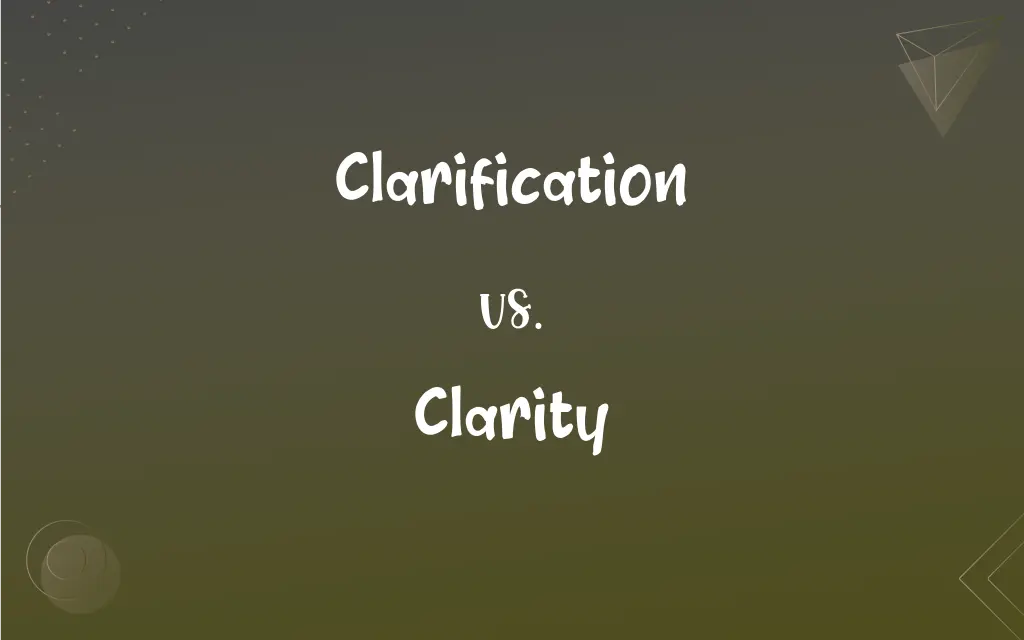Clarification vs. Clarity: What's the Difference?
Edited by Janet White || By Harlon Moss || Published on November 19, 2023
Clarification is the process of making something clear or understandable; clarity is the state of being clear or understandable.

Key Differences
Clarification is an action or process aimed at resolving confusion or doubt. It involves making something less ambiguous or more comprehensible. For instance, asking for clarification on a project means seeking additional information that makes the project’s requirements more understandable. On the other hand, clarity refers to the clearness or lucidity of an expression, sound, or image. It signifies the quality of being easily understood or the degree to which something is clear and free of ambiguity.
In the context of communication, clarification is often sought or provided when the message conveyed is not immediately clear to the receiver. It is a step taken to eliminate misunderstandings. Clarification could involve rephrasing, providing examples, or elaborating on a point. Clarity, however, is the characteristic of a message that has already been made clear. A clear explanation or instruction has clarity, meaning that the receiver can comprehend it without additional information.
When one requests clarification, they are asking for something to be made clear. This could be in the form of an explanation or additional information that sheds light on a subject. For example, a student might ask a teacher for clarification of complex material. Clarity is what is achieved once clarification has been provided. It is the end goal of seeking clarification, resulting in understanding and absence of confusion.
Clarification can also be a corrective measure. It’s what one seeks when they realize there has been a misunderstanding or when they anticipate that a point may not be immediately grasped by the audience. Clarity is the preventative measure; it’s what the communicator strives for in the initial message—to articulate thoughts in a way that avoids the need for clarification.
The necessity of clarification arises from the initial lack of clarity. Without clarity, there is potential for misinterpretation, confusion, and errors. Clarification is therefore an essential process in achieving clarity, ensuring that communication is effective and that the parties involved are on the same page. Clarity is not just the absence of ambiguity, but also the presence of simplicity and comprehensibility in communication.
ADVERTISEMENT
Comparison Chart
Definition
The process of making clear
The state of being clear
Purpose
To resolve confusion or explain
To be understood without doubt
Nature
Active process
Inherent quality
Stage in Communication
Post-message to resolve ambiguity
Pre-message as a characteristic of good communication
Outcome
Understanding after explanation
Immediate understanding without need for further explanation
ADVERTISEMENT
Clarification and Clarity Definitions
Clarification
Act of explaining.
He provided clarification on the new policy.
Clarity
Ease of understanding.
His explanation was given with great clarity.
Clarification
Making clear.
After her clarification, the math problem made sense.
Clarity
Distinctness of expression.
His clarity of speech is effective in debates.
Clarification
Removing ambiguity.
The manager's clarification resolved the team's doubts.
Clarity
Freedom from ambiguity.
The clarity of her answer made everyone nod in agreement.
Clarification
Elucidation.
The scientist’s clarification helped the audience understand the complex concept.
Clarity
State of transparency.
The clarity of the instructions was appreciated.
Clarification
Providing more details.
She asked for clarification of the instructions.
Clarity
Sharpness of perception.
The clarity of the photograph was stunning.
Clarification
To make clear or easier to understand; elucidate
Clarified her intentions.
Clarity
Clearness of appearance
The clarity of the mountain air.
Clarification
To clear of confusion or uncertainty
Clarify the mind.
Clarity
Clearness of thought or style; lucidity
Writes with clarity and perception.
Clarification
To make clear by removing impurities or solid matter, as by heating gently or filtering
Clarify butter.
FAQs
How does one achieve clarity in writing?
Through concise language and straightforward explanations.
How can businesses ensure clarity in their messaging?
By using simple language and avoiding jargon.
What does clarity mean?
It refers to the quality of being clear and easy to understand.
Can clarification change the meaning of information?
It should not change the meaning but make it clearer.
What are examples of clarity in communication?
Clear instructions, definitive statements, and unambiguous language.
What role does context play in the need for clarification?
Misunderstandings due to context can often necessitate clarification.
When should one seek clarification?
When there's confusion or misunderstanding about information.
Is clarity subjective?
While clarity aims to be objective, individual understanding can vary.
Why is clarification important in communication?
To ensure all parties have the same understanding.
Does clarity guarantee understanding?
It increases the likelihood but doesn't guarantee it due to individual differences.
What is clarification?
It is the process of making something clear or easier to understand.
Can over-clarification be problematic?
Yes, it can lead to information overload or patronization.
How can one ask for clarification politely?
By expressing genuine interest in understanding better.
Is there a cultural aspect to clarity and clarification?
Yes, cultural differences can affect communication clarity and the approach to clarification.
What's the relationship between brevity and clarity?
Brevity can enhance clarity by reducing the chance for confusion.
How can teachers provide clarification?
By giving additional examples or rephrasing difficult concepts.
Can clarity exist without clarification?
Yes, if the initial communication is already clear.
Does clarity enhance credibility?
Generally, clear communication is associated with reliability.
Can visual aids improve clarity?
Yes, they can make abstract concepts more tangible.
What's the difference between clarification and explanation?
Clarification focuses on clearing up confusion; explanation provides detailed information.
About Author
Written by
Harlon MossHarlon is a seasoned quality moderator and accomplished content writer for Difference Wiki. An alumnus of the prestigious University of California, he earned his degree in Computer Science. Leveraging his academic background, Harlon brings a meticulous and informed perspective to his work, ensuring content accuracy and excellence.
Edited by
Janet WhiteJanet White has been an esteemed writer and blogger for Difference Wiki. Holding a Master's degree in Science and Medical Journalism from the prestigious Boston University, she has consistently demonstrated her expertise and passion for her field. When she's not immersed in her work, Janet relishes her time exercising, delving into a good book, and cherishing moments with friends and family.






































































